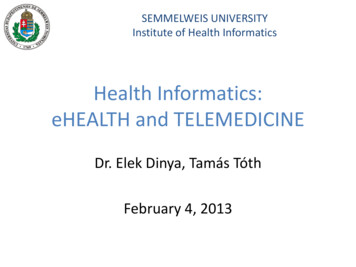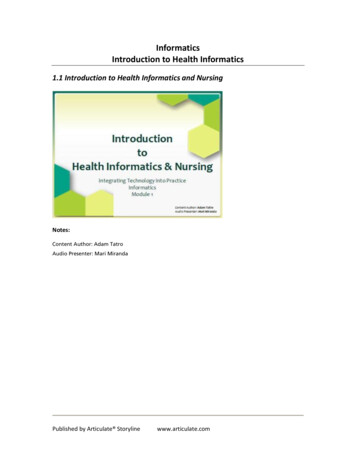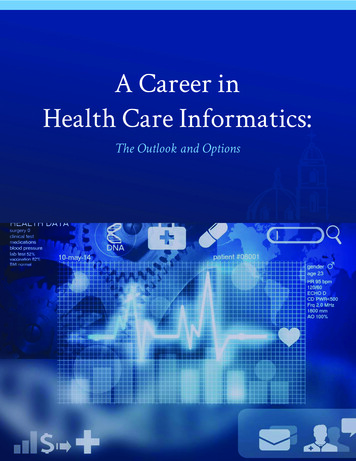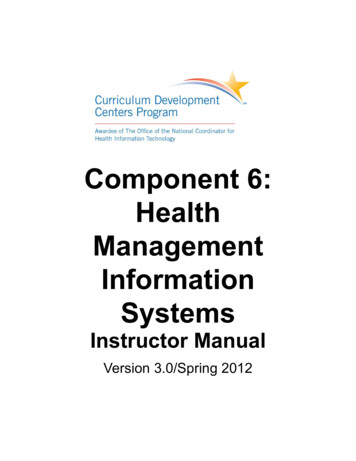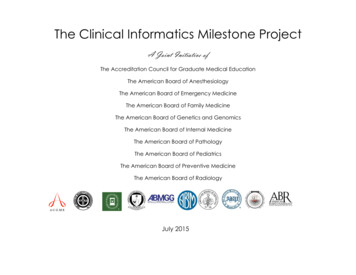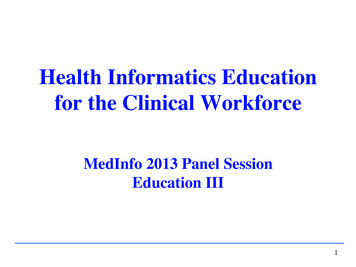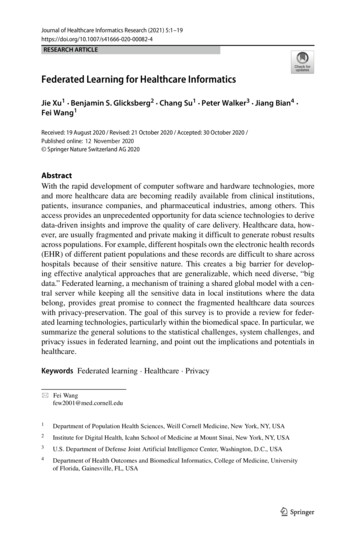
Transcription
Journal of Healthcare Informatics Research (2021) RESEARCH ARTICLEFederated Learning for Healthcare InformaticsJie Xu1 · Benjamin S. Glicksberg2 · Chang Su1 · Peter Walker3 · Jiang Bian4 ·Fei Wang1Received: 19 August 2020 / Revised: 21 October 2020 / Accepted: 30 October 2020 /Published online: 12 November 2020 Springer Nature Switzerland AG 2020AbstractWith the rapid development of computer software and hardware technologies, moreand more healthcare data are becoming readily available from clinical institutions,patients, insurance companies, and pharmaceutical industries, among others. Thisaccess provides an unprecedented opportunity for data science technologies to derivedata-driven insights and improve the quality of care delivery. Healthcare data, however, are usually fragmented and private making it difficult to generate robust resultsacross populations. For example, different hospitals own the electronic health records(EHR) of different patient populations and these records are difficult to share acrosshospitals because of their sensitive nature. This creates a big barrier for developing effective analytical approaches that are generalizable, which need diverse, “bigdata.” Federated learning, a mechanism of training a shared global model with a central server while keeping all the sensitive data in local institutions where the databelong, provides great promise to connect the fragmented healthcare data sourceswith privacy-preservation. The goal of this survey is to provide a review for federated learning technologies, particularly within the biomedical space. In particular, wesummarize the general solutions to the statistical challenges, system challenges, andprivacy issues in federated learning, and point out the implications and potentials inhealthcare.Keywords Federated learning · Healthcare · Privacy Fei Wangfew2001@med.cornell.edu1Department of Population Health Sciences, Weill Cornell Medicine, New York, NY, USA2Institute for Digital Health, Icahn School of Medicine at Mount Sinai, New York, NY, USA3U.S. Department of Defense Joint Artificial Intelligence Center, Washington, D.C., USA4Department of Health Outcomes and Biomedical Informatics, College of Medicine, Universityof Florida, Gainesville, FL, USA
2Journal of Healthcare Informatics Research (2021) 5:1–191 IntroductionThe recent years have witnessed a surge of interest related to healthcare data analytics, due to the fact that more and more such data are becoming readily available fromvarious sources including clinical institutions, patient individuals, insurance companies, and pharmaceutical industries, among others. This provides an unprecedentedopportunity for the development of computational techniques to dig data-driveninsights for improving the quality of care delivery [72, 105].Healthcare data are typically fragmented because of the complicated nature ofthe healthcare system and processes. For example, different hospitals may be ableto access the clinical records of their own patient populations only. These recordsare highly sensitive with protected health information (PHI) of individuals. Rigorousregulations, such as the Health Insurance Portability and Accountability Act (HIPAA)[32], have been developed to regulate the process of accessing and analyzing suchdata. This creates a big challenge for modern data mining and machine learning (ML)technologies, such as deep learning [61], which typically requires a large amount oftraining data.Federated learning is a paradigm with a recent surge in popularity as it holds greatpromise on learning with fragmented sensitive data. Instead of aggregating data fromdifferent places all together, or relying on the traditional discovery then replicationdesign, it enables training a shared global model with a central server while keepingthe data in local institutions where the they originate.The term “federated learning” is not new. In 1976, Patrick Hill, a philosophy professor, first developed the Federated Learning Community (FLC) to bring peopletogether to jointly learn, which helped students overcome the anonymity and isolationin large research universities [42]. Subsequently, there were several efforts aiming atbuilding federations of learning content and content repositories [6, 74, 83]. In 2005,Rehak et al. [83] developed a reference model describing how to establish an interoperable repository infrastructure by creating federations of repositories, where themetadata are collected from the contributing repositories into a central registry provided with a single point of discovery and access. The ultimate goal of this modelis to enable learning from diverse content repositories. These practices in federatedlearning community or federated search service have provided effective referencesfor the development of federated learning algorithms.Federated learning holds great promises on healthcare data analytics. For bothprovider (e.g., building a model for predicting the hospital readmission risk withpatient Electronic Health Records (EHR) [71]) and consumer (patient)-based applications (e.g., screening atrial fibrillation with electrocardiograms captured by smartwatch [79]), the sensitive patient data can stay either in local institutions or withindividual consumers without going out during the federated model learning process,which effectively protects the patient privacy. The goal of this paper is to review thesetup of federated learning, discuss the general solutions and challenges, and envisionits applications in healthcare.In this review, after a formal overview of federated learning, we summarize themain challenges and recent progress in this field. Then we illustrate the potential offederated learning methods in healthcare by describing the successful recent research.
Journal of Healthcare Informatics Research (2021) 5:1–193At last, we discuss the main opportunities and open questions for future applicationsin healthcare.Difference with Existing Reviews There has been a few review articles on federatedlearning recently. For example, Yang et al. [109] wrote the early federated learningsurvey summarizing the general privacy-preserving techniques that can be appliedto federated learning. Some researchers surveyed sub-problems of federated learning, e.g., personalization techniques [59], semi-supervised learning algorithms [49],threat models [68], and mobile edge networks [66]. Kairouz et al. [51] discussedrecent advances and presented an extensive collection of open problems and challenges. Li et al. [63] conducted the review on federated learning from a systemviewpoint. Different from those reviews, this paper provided the potential of federated learning to be applied in healthcare. We summarized the general solution to thechallenges in federated learning scenario and surveyed a set of representative federated learning methods for healthcare. In the last part of this review, we outlined somedirections or open questions in federated learning for healthcare. An early version ofthis paper is available on arXiv [107].2 Federated LearningFederated learning is a problem of training a high-quality shared global model witha central server from decentralized data scattered among large number of differentclients (Fig. 1). Mathematically, assume there are K activated clients where the datareside in (a client could be a mobile phone, a wearable device, or a clinical institutiondata warehouse, etc.). Let Dk denote the data distribution associated with client k andFig. 1 Schematic of the federated learning framework. The model is trained in a distributed manner: theinstitutions periodically communicate the local updates with a central server to learn a global model; thecentral server aggregates the updates and sends back the parameters of the updated global model
4Journal of Healthcare Informatics Research (2021) 5:1–19 nk the number of samples available from that client. n Kk 1 nk is the total samplesize. Federated learning problem boils down to solving a empirical risk minimizationproblem of the form [56, 57, 69]:min F (w) : w RdK nkk 1nFk (w)where Fk (w) : 1 fi (w),nk(1)xi Dkwhere w is the model parameter to be learned. The function fi is specified via a lossfunction dependent on a pair of input-output data pair {xi , yi }. Typically, xi Rdand yi R or yi { 1, 1}. Simple examples include:–––2linear regression: fi (w) 12 (x i w yi ) , yi R;logistic regression: fi (w) log(1 exp( yi x i w)), yi { 1, 1};support vector machines: fi (w) max{0, 1 yi x i w}, yi { 1, 1}.In particular, algorithms for federated learning face with a number of challenges [13, 96], specifically:–––Statistical Challenge: The data distribution among all clients differ greatly, i.e., k k̃, we have Exi Dk [fi (w; xi )] Exi Dk̃ [fi (w; xi )]. It is such that any datapoints available locally are far from being a representative sample of the overalldistribution, i.e., Exi Dk [fi (w; xi )] F (w).Communication Efficiency: The number of clients K is large and can be muchbigger than the average number of training sample stored in the activated clients,i.e., K (n/K).Privacy and Security: Additional privacy protections are needed for unreliableparticipating clients. It is impossible to ensure all clients are equally reliable.Next, we will survey, in detail, the existing federated learning related works onhandling such challenges.2.1 Statistical Challenges of Federated LearningThe naive way to solve the federated learning problem is through Federated Averaging (FedAvg) [69]. It is demonstrated can work with certain non independentidentical distribution (non-IID) data by requiring all the clients to share the samemodel. However, FedAvg does not address the statistical challenge of strongly skeweddata distributions. The performance of convolutional neural networks trained withFedAvg algorithm can reduce significantly due to the weight divergence [111]. Existing research on dealing with the statistical challenge of federated learning can begrouped into two fields, i.e., consensus solution and pluralistic solution.2.1.1 Consensus SolutionMost centralized models are trained on the aggregated training samples obtained fromthe samples drawn from the local clients [96, 111]. Intrinsically, the centralized modelis trained to minimize the loss with respect to the uniform distribution [73]: D̄
Journal of Healthcare Informatics Research (2021) 5:1–195 Knkk 1 n Dk ,where D̄ is the target data distribution for the learning model. However,this specific uniform distribution is not an adequate solution in most scenarios.To address this issue, the recent proposed solution is to model the target distribution or force the data adapt to the uniform distribution [73, 111]. Specifically, Mohriet al. [73] proposed a minimax optimization scheme, i.e., agnostic federated learning(AFL), where the centralized model is optimized for any possible target distributionformed by a mixture of the client distributions. This method has only been appliedat small scales. Compared to AFL, Li et al. [64] proposed q-Fair Federated Learning(q-FFL), assigning higher weight to devices with poor performance, so that the distribution of accuracy in the network reduces in variance. They empirically demonstratethe improved flexibility and scalability of q-FFL compared to AFL.Another commonly used method is globally sharing a small portion of databetween all the clients [75, 111]. The shared subset is required containing a uniformdistribution over classes from the central server to the clients. In addition to handle non-IID issue, sharing information of a small portion of trusted instances andnoise patterns can guide the local agents to select compact training subset, while theclients learn to add changes to selected data samples, in order to improve the testperformance of the global model [38].2.1.2 Pluralistic SolutionGenerally, it is difficult to find a consensus solution w that is good for all componentsDi . Instead of wastefully insisting on a consensus solution, many researchers chooseto embracing this heterogeneity.Multi-task learning (MTL) is a natural way to deal with the data drawn fromdifferent distributions. It directly captures relationships among non-IID and unbalanced data by leveraging the relatedness between them in comparison to learn asingle global model. In order to do this, it is necessary to target a particular way inwhich tasks are related, e.g., sharing sparsity, sharing low-rank structure, and graphbased relatedness. Recently, Smith et al. [96] empirically demonstrated this point onreal-world federated datasets and proposed a novel method MOCHA to solve a general convex MTL problem with handling the system challenges at the same time.Later, Corinzia et al. [22] introduced VIRTUAL, an algorithm for federated multi-tasklearning with non-convex models. They consider the federation of central server andclients as a Bayesian network and perform training using approximated variationalinference. This work bridges the frameworks of federated and transfer/continuouslearning.The success of multi-task learning rests on whether the chosen relatednessassumptions hold. Compared to this, pluralism can be a critical tool for dealing withheterogeneous data without any additional or even low-order terms that depend onthe relatedness as in MTL [28]. Eichner et al. [28] considered training in the presenceof block-cyclic data and showed that a remarkably simple pluralistic approach canentirely resolve the source of data heterogeneity. When the component distributionsare actually different, pluralism can outperform the “ideal” IID baseline.
Journal of Healthcare Informatics Research (2021) 5:1–1962.2 Communication Efficiency of Federated LearningIn federated learning setting, training data remain distributed over a large number ofclients each with unreliable and relatively slow network connections. Naively for synchronous protocol in federated learning [58, 96], the total number of bits that requiredduring uplink (clinets server) and downlink (server clients) communication byeach of the K clients during training is given by:B up/down O(U w (H ( wup/down ) β)) (2)update sizewhere U is the total number of updates performed by each client, w is the sizeof the model and H ( wup/down ) is the entropy of the weight updates exchangedduring transmitting process. β is the difference between the true update size andthe minimal update size (which is given by the entropy) [89]. Apparently, we canconsider three ways to reduce the communication cost: (a) reduce the number ofclients K, (b) reduce the update size, (c) reduce the number of updates U . Startingat these three points, we can organize existing research on communication-efficientfederated learning into four groups, i.e., model compression, client selection, updatesreducing, and peer-to-peer learning (Fig. 2).2.2.1 Client SelectionThe most natural and rough way for reducing communication cost is to restrict theparticipated clients or choose a fraction of parameters to be updated at each round.Shokri et al. [92] use the selective stochastic gradient descent protocol, where theFig. 2 Communication efficient federated learning methods. Existing research on improving communication efficiency can be categorized into a model compression, b client selection, c updates reducing, and dpeer-to-peer learning
Journal of Healthcare Informatics Research (2021) 5:1–197selection can be completely random or only the parameters whose current valuesare farther away from their local optima are selected, i.e., those that have a largergradient. Nishio et al. [75] proposed a new protocol referred to as FedCS, wherethe central server manages the resources of heterogeneous clients and determineswhich clients should participate the current training task by analyzing the resourceinformation of each client, such as wireless channel states, computational capacities,and the size of data resources relevant to the current task. Here, the server shoulddecide how much data, energy, and CPU resources used by the mobile devices suchthat the energy consumption, training latency, and bandwidth cost are minimizedwhile meeting requirements of the training tasks. Anh [5] thus proposes to use theDeep Q-Learning [102] technique that enables the server to find the optimal dataand energy management for the mobile devices participating in the mobile crowdmachine learning through federated learning without any prior knowledge of networkdynamics.2.2.2 Model CompressionThe goal of model compression is to compress the server-to-client exchanges toreduce uplink/downlink communication cost. The first way is through structuredupdates, where the update is directly learned from a restricted space parameterizedusing a smaller number of variables, e.g., sparse, low-rank [58], or more specifically,pruning the least useful connections in a network [37, 113], weight quantization [17,89], and model distillation [43]. The second way is lossy compression, where a fullmodel update is first learned and then compressed using a combination of quantization, random rotations, and subsampling before sending it to the server [2, 58]. Thenthe server decodes the updates before doing the aggregation.Federated dropout, in which each client, instead of locally training an update tothe whole global model, trains an update to a smaller sub-model [12]. These submodels are subsets of the global model and, as such, the computed local updateshave a natural interpretation as updates to the larger global model. Federated dropoutnot only reduces the downlink communication but also reduces the size of uplinkupdates. Moreover, the local computational costs is correspondingly reduced sincethe local training procedure dealing with parameters with smaller dimensions.2.2.3 Updates ReductionKamp et al. [52] proposed to average models dynamically depending on the utility ofthe communication, which leads to a reduction of communication by an order of magnitude compared to periodically communicating state-of-the-art approaches. Thisfacet is well suited for massively distributed systems with limited communicationinfrastructure. Bui et al. [11] improved federated learning for Bayesian neural networks using partitioned variational inference, where the client can decide to uploadthe parameters back to the central server after multiple passes through its data, afterone local epoch, or after just one mini-batch. Guha et al. [35] focused on techniquesfor one-shot federated learning, in which they learn a global model from data inthe network using only a single round of communication between the devices and
8Journal of Healthcare Informatics Research (2021) 5:1–19Fig. 3 Privacy-preserving schemes. a Secure multi-party computation. In security sharing, security values(blue and yellow pie) are split into any number of shares that are distributed among the computing nodes.During the computation, no computation node is able to recover the original value nor learn anything aboutthe output (green pie). Any nodes can combine their shares to reconstruct the original value. b Differentialprivacy. It guarantees that anyone seeing the result of a differentially private analysis will make the sameinference (answer 1 and answer 2 are nearly indistinguishable)the central server. Besides above works, Ren et al. [84] theoretically analyzed thedetailed expression of the learning efficiency in the CPU scenario and formulate atraining acceleration problem under both communication and learning resource budget. Reinforcement learning and round robin learning are widely used to manage thecommunication and computation resources [5, 46, 106, 114].2.2.4 Peer-to-Peer LearningIn federated learning, a central server is required to coordinate the training process ofthe global model. However, the communication cost to the central server may be notaffordable since a large number of clients are usually involved. Also, many practicalpeer-to-peer networks are usually dynamic, and it is not possible to regularly access afixed central server. Moreover, because of the dependence on central server, all clientsare required to agree on one trusted central body, and whose failure would interruptthe training process for all clients. Therefore, some researches began to study fullydecentralized framework where the central server is not required [41, 60, 85, 91]. Thelocal clients are distributed over the graph/network where they only communicatewith their one-hop neighbors. Each client updates its local belief based on own dataand then aggregates information from the one-hop neighbors.2.3 Privacy and SecurityIn federated learning, we usually assume the number of participated clients (e.g.,phones, cars, clinical institutions.) is large, potentially in the thousands or millions.It is impossible to ensure none of the clients is malicious. The setting of federatedlearning, where the model is trained locally without revealing the input data or themodel’s output to any clients, prevents direct leakage while training or using themodel. However, the clients may infer some information about another client’s private dataset given the execution of f (w), or over the shared predictive model w [100].To this end, there have been many efforts focus on privacy either from an individual
Journal of Healthcare Informatics Research (2021) 5:1–199point of view or multiparty views, especially in social media field which significantlyexacerbated multiparty privacy (MP) conflicts [97, 98] (Fig. 3).2.3.1 Secure Multi-party ComputationSecure multi-party computation (SMC) has a natural application to federated learningscenarios, where each individual client uses a combination of cryptographic techniques and oblivious transfer to jointly compute a function of their private data [8,78]. Homomorphic encryption is a public key system, where any party can encryptits data with a known public key and perform calculations with data encrypted byothers with the same public key [29]. Due to its success in cloud computing, it comesnaturally into this realm, and it has certainly been used in many federated learningresearches [14, 40].Although SMC guarantees that none of the parties shares anything with each otheror with any third party, it can not prevent an adversary from learning some individual information, e.g., which clients’ absence might change the decision boundaryof a classifier, etc. Moreover, SMC protocols are usually computationally expensiveeven for the simplest problems, requiring iterated encryption/decryption and repeatedcommunication between participants about some of the encrypted results [78].2.3.2 Differential PrivacyDifferential privacy (DP) [26] is an alternative theoretical model for protecting theprivacy of individual data, which has been widely applied to many areas, not onlytraditional algorithms, e.g., boosting [27], principal component analysis [15], support vector machine [86], but also deep learning research [1, 70]. It ensures thatthe addition or removal does not substantially affect the outcome of any analysisand is thus also widely studied in federated learning research to prevent the indirectleakage [1, 70, 92]. However, DP only protects users from data leakage to a certain extent and may reduce performance in prediction accuracy because it is a lossymethod [18]. Thus, some researchers combine DP with SMC to reduce the growth ofnoise injection as the number of parties increases without sacrificing privacy whilepreserving provable privacy guarantees, protecting against extraction attacks andcollusion threats [18, 100].3 ApplicationsFederated learning has been incorporated and utilized in many domains. Thiswidespread adoption is due in part by the fact that it enables a collaborative modeling mechanism that allows for efficient ML all while ensuring data privacy and legalcompliance between multiple parties or multiple computing nodes. Some promising examples that highlight these capabilities are virtual keyboard prediction [39,70], smart retail [112], finance [109], and vehicle-to-vehicle communication [88]. Inthis section, we focus primarily on applications within the healthcare space and also
10Journal of Healthcare Informatics Research (2021) 5:1–19discuss promising applications in other domains since some principles can be appliedto healthcare.3.1 HealthcareEHRs have emerged as a crucial source of real world healthcare data that has beenused for an amalgamation of important biomedical research [30, 47], including formachine learning research [72]. While providing a huge amount of patient data foranalysis, EHRs contain systemic and random biases overall and specific to hospitalsthat limit the generalizability of results. For example, Obermeyer et al. [76] foundthat a commonly used algorithm to determine enrollment in specific health programswas biased against African Americans, assigning the same level of risk to healthierCaucasian patients. These improperly calibrated algorithms can arise due to a varietyof reasons, such as differences in underlying access to care or low representation intraining data. It is clear that one way to alleviate the risk for such biased algorithms isthe ability to learn from EHR data that is more representative of the global populationand which goes beyond a single hospital or site. Unfortunately, due to a myriad ofreasons such as discrepant data schemes and privacy concerns, it is unlikely that datawill eve be connected together in a single database to learn from all at once. Thecreation and utility of standardized common data models, such as OMOP [44], allowfor more wide-spread replication analyses but it does not overcome the limitationsof joint data access. As such, it is imperative that alternative strategies emerge forlearning from multiple EHR data sources that go beyond the common discoveryreplication framework. Federated learning might be the tool to enable large-scalerepresentative ML of EHR data and we discuss many studies which demonstrate thisfact below.Federated learning is a viable method to connect EHR data from medical institutions, allowing them to share their experiences, and not their data, with a guaranteeof privacy [9, 25, 34, 45, 65, 82]. In these scenarios, the performance of ML modelwill be significantly improved by the iterative improvements of learning from largeand diverse medical data sets. There have been some tasks were studied in federated learning setting in healthcare, e.g., patient similarity learning [62], patientrepresentation learning, phenotyping [55, 67], and predictive modeling [10, 45, 90].Specifically, Lee et al. [62] presented a privacy-preserving platform in a federatedsetting for patient similarity learning across institutions. Their model can find similar patients from one hospital to another without sharing patient-level information.Kim et al. [55] used tensor factorization models to convert massive electronic healthrecords into meaningful phenotypes for data analysis in federated learning setting.Liu et al. [67] conducted both patient representation learning and obesity comorbidityphenotyping in a federated manner and got good results. Vepakomma et al. [103] builtseveral configurations upon a distributed deep learning method called SplitNN [36]to facilitate the health entities collaboratively training deep learning models withoutsharing sensitive raw data or model details. Silva et al. [93] illustrated their federatedlearning framework by investigating brain structural relationships across diseasesand clinical cohorts. Huang et al. [45] sought to tackle the challenge of non-IIDICU patient data by clustering patients into clinically meaningful communities that
Journal of Healthcare Informatics Research (2021) 5:1–1911captured similar diagnoses and geological locations and simultaneously training onemodel per community.Federated learning has also enabled predictive modeling based on diverse sources,which can provide clinicians with additional insights into the risks and benefits oftreating patients earlier [9, 10, 90]. Brisimi et al. [10] aimed to predict future hospitalizations for patients with heart-related diseases using EHR data spread among variousdata sources/agents by solving the l1 -regularized sparse Support Vector Machineclassifier in federated learning environment. Owkin is using federated learning topredict patients’ resistance to certain treatment and drugs, as well as their survivalrates for certain diseases [99]. Boughorbel et al. [9] proposed a federated uncertaintyaware learning algorithm for the prediction of preterm birth from distributed EHR,where the contribution of models with high uncertainty in the aggregation model isreduced. Pfohl et al. [80] considered the prediction of prolonged length of stay andin-hospital mortality across thirty-one hospitals in the eICU Collaborative ResearchDatabase. Sharma et al. [90] tested a privacy preserving framework for the task ofin-hospital mortality prediction among patients admitted to the intensive care unit(ICU). Their results show that training the model in the federated learning framework leads to comparable performance to the traditional centralized learning setting.Summary of these work is listed in Table 1.3.2 OthersAn important application of federated learning is for natural language processing(NLP) tasks. When Google first proposed federated learning concept in 2016, theapplication scenario is Gboard—a virtual keyboard of Google for touchscreen mobiledevices with support for more than 600 language varieties [39, 70]. Indeed, as usersincreasingly turn to mobile devices, fast mobile input methods with auto-correction,word completion, and next-word prediction features are becoming more and moreimportant. For these NLP tasks, especially next-word prediction, typed text in mobileapps is usually better than the
2 Institute for Digital Health, Icahn School of Medicine at Mount Sinai, New York, NY, USA 3 U.S. Department of Defense Joint Artificial Intelligence Center, Washington, D.C., USA 4 Department of Health Outcomes and Biomedical Informatics, College of Medicine, University of Flori
